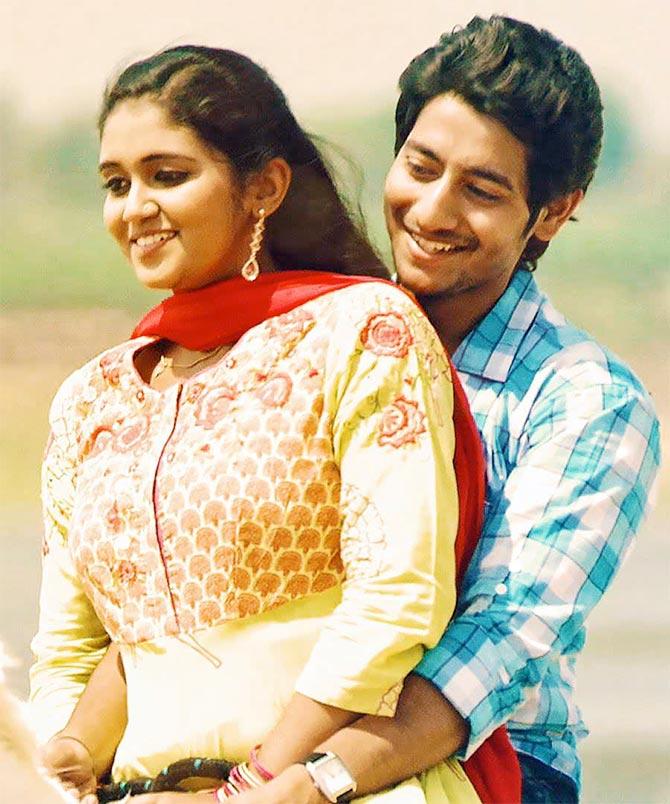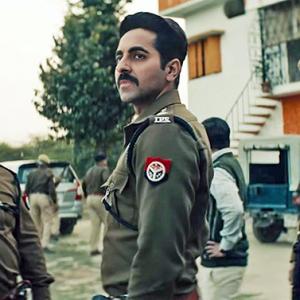'Dibakar Banerjee isn't simply giving a particular fascistic regime the finger.'
'Here, he wants to offer us a preview of the invisible forces and human tendencies that drive fascism, blind conformity, and mass hysteria,' says Sreehari Nair.

In the otherwise intolerable and unimaginatively titled, Ghost Stories, there are two stories you can endure, though for entirely different reasons: Dibakar Banerjee's story, because it is the most relaxed of the lot, and Karan Johar's, because it seems completely unaware of how bad it is.
While Banerjee's short can be enjoyed for its vision, Johar's can be consumed as a glorious piece of camp.
But there is something more about these two 30 minute features that makes them stand out in the dung pile.
Both Banerjee's and Johar's works, in their separate ways, are examples of horror stories that hold some personal meaning for their creators.
This is not the claim one can make about Zoya Akhtar's and Anurag Kashyap's shorts, both of which play by the genre's rulebook and die by its hackneyed rules.
In his masterful section of Lust Stories (which I still regard the best of the 12 shorts that these four directors have collectively put out), Banerjee had demonstrated a new kind of artistry.
In taking a conventional tale of adultery and turning it into a woozy bedroom farce, Banerjee had indicated that he was willing to be freer and more exploratory with his themes and subjects, and also be more generous in his technique.
Banerjee 2.0 came with the promise of shedding his customary coldness while continuing to be unsentimental and unsparing.
His newly minted coat of arms stands Banerjee in good stead, this time around as well.
In his story, a man (played by Sukant Goel) visits a small town and discovers that the quaint-looking town has been turned into a land of zombies through a series of strategies carefully planned and executed by the leading lights of an adjoining, bigger, town.
It would be adequate but lazy (and self-congratulatory also, on the part of those who commit themselves to such easy deductions) to read this story as a mere allegory for the present times (only the unambitious make a great fuss about timeliness in art. The truly visionary artist is content with being timeless).
I believe Dibakar Banerjee isn't simply giving a particular fascistic regime the finger. Here, he wants to offer us a preview of the invisible forces and human tendencies that drive fascism, blind conformity, and mass hysteria.
I saw Banerjee's story as a clever retelling of Eugene Ionesco's play Rhinoceros(which broadly speaking, was about the inhabitants of a town turning into rhinoceroses), and like Ionesco there, Banerjee is performing here what Chekhov said was the job of an artist: To not solve the problem, but to state the problem correctly.
Banerjee shows us how fascism spreads, through a combination of public apathy, bloodlust, a yearning for an imaginary golden past, and on account of people having to choose between death and complying with the authority at hand.
Banerjee's story is a political allegory in the broadest sense but look closely and it is a sad song about the vagaries of human nature that make fascism possible, and make it almost inescapable.
What's ultimately heart-breaking about Banerjee's tale, what gives it its peculiar horror, is that the best people in it lack all conviction while the worst are full of passionate intensity.
The three characters with any semblance of goodness in them, the outsider played by Sukant Goel, and two kids -- who are the only human survivors in the zombie-land -- at different points in the story, threaten to, or openly betray one another.
And when there's no one left to betray, Goel's character ends up turning against himself.
The difference between Dibakar Banerjee of the pre and post-Lust Stories era is that now he seems to be not clutching tightly onto his ideas, but spreading them across the many elements that make up his tapestry.
And so, we see the seemingly bleak story here enlivened by, darkly comic visual elements (a small kid using a helmet to shield his identity), a character like that of Sukant Goel's (who possesses an authorial consciousness of his own), and frightening scenes that are balanced by touches of behaviour (Gulshan Devaiah running his tongue between his teeth, as if picking out the leftovers of his last meal, while detailing his plans for a beautiful, majoritarian future).
Now, you might as well skip directly to Banerjee's story, which appears third in this anthology, because the preceding ones are more intent on offering you literal interpretations of the horror genre.

Anurag Kashyap's short is probably his worst work, counting even his early ones as an amateur film-maker.
This joyless, airless, film, about a pregnant woman (Sobhita Dhulipala) and the myth of a bird curse is less a creation and more a scream of agony.
There's none of the kinky visual humour one associates with Kashyap, and his use of actors has never felt so restricting.
The performances and shots all fall away on the altar of advancing the plot, so that you get to experience none of the small pleasures that typically support the director's grand designs.

There are at least a few more pleasures to be experienced in Zoya Akhtar's section, such as when a bed-ridden, frail, yet psychically-gifted, Surekha Sikri takes a break from her wallowing to recite with vacant eyes Wordsworth's Intimations of Immortality.
Sikri's recitation magically becomes the theme and spirit of her character ('The glory and the freshness of a dream. It is not now as it hath been of yore,' she chants away).
This short has Jahnavi Kapoor as Sameera, a nurse assigned to take care of the cantankerous lady that Sikri plays. The wrinkled, toothless woman waits for her son, while Sameera waits for her much-married boyfriend (played by a sneaky Vijay Verma).
I liked the freeness with which Kapoor drifted through the chambers of the old lady's house, spreading clouds of incense all around, and I saw in her performance a talent for hinting at her character's emotional needs and physical desires, using the smallest of her movements.
Both Kapoor's and Sikri's characters are interesting in their own right, but they don't belong to the world of this particular movie. It's as if Akhtar had these people developed for another project, and then, at the very last minute, whipped them into this narrative.

Karan Johar's short is poorly acted and poorly mounted, with god-awful lines by Niranjan Iyengar.
There are passages of characters trying to outsmart each other using hashtag-level back-and-forth and then, as if suddenly waking up to the premise of the film, sounding over-sincere and cloying.
And yet, such incongruities in it are precisely why I liked Johar's short more than Kashyap's and Akhtar's efforts.
Johar's inclusion in this enterprise (which started with Bombay Talkies and then progressed to Lust Stories) was, from the very beginning, an act of someone being shoehorned into an artistic space he did not naturally belong to. And our man has responded to this challenge by way of stories that are basically jokes on his own filmography.
The short film, in effect, seems to have become the category where the worn-out ideas and sensibilities of Johar's full-length films get cleansed of their sins (It's all about killing your artistic upbringing!).
While the first two anthologies had unpleasant truths and lust intruding into Joharville, it's a vicious dead granny who makes the trip this time.
The hero of Johar's story (Avinash Tiwary) talks to his long-dead grandmother, and it gives his wife (Mrunal Thakur) the creeps.
The above bit may have handed his film its plotline, but it's the gaps in Johar's understanding of this world, and the gaps in his feeling for horror as a genre that coat the film with an irrepressible artifice, and which finally gives it its unique texture.
The Tiwary-Thakur chemistry, for all the dirty talk, is largely sexless and oblivious to certain essential truths (For example, what idiot says 'I love you' when deep in the throes of passion?) I was rolling in the aisles, every time the couple made love.
You can't tell if Avinash Tiwary is playing the granny-obsessed man straight, or if he is playing him in all jest.
The characters's reactions and their temperaments are gross exaggerations. Kitu Gidwani, playing the mother-in-law, uses her stiff neck and her ominous sighs to convince us that doomsday is coming. It's a gloriously hammy performance!
I read Johar's short as the story of a sane Mrunal Thakur entering a horror movie world, filled with horror movie stereotypes, and her trying to break free. And it tickled me to share some of her misery, and also her disbelief.
Thinking about it now, I think I enjoyed Karan Johar's short so much because it fulfilled the unspoken dharma of a horror movie.
It's not for nothing that the best horror movies are often deemed close to comedies. For how can you not cackle at the bizarre visuals, the extreme physicality of the actors involved, and the kitschification of all things that horror movies provide by the frameful?
I had stepped into Ghost Stories curious to check which of the four films in the anthology would make me laugh the loudest.
Banerjee's and Johar's shorts are the most effective of the ghost stories because they seem to have a sense of humour.
Banerjee achieves this through design. Check out for the scene where the head zombie studies the three human characters, causing them to freeze in mid-sentence. Now that's a visual straight out of the Theatre of the Absurd.
And in Johar's film, one with granny issues, it's in the quest to create tension that chuckles get loosed into the air. Like when Mrunal Thakur, towards the end, yells 'F*** you Granny!' it's as though she is speaking for all of us in the audience.
I just wish the other two films had the good sense to drop some of their self-seriousness.
What made the four shorts in Lust Stories so immensely enjoyable was the river of cheerfulness that flowed beneath those tales of passion.
It was a complex cheerfulness, sort of like laughing in the middle of an orgasm, and yet, this gave the whole anthology, a fresh feeling.
It's odd when artists who showed such fluidity in the past, forsake their good spirits, and turn dreary upon hearing the word 'Ghost' uttered.
Such piousness is no sign of greater artistry. If anything, it means that you consider it okay to joke about sex but blasphemous to joke about the dead.

Sreehari Nair wishes to write about that which is in the cultural air, but absent from trending lists. He can be reached at sreeharin@rediff-inc.com










